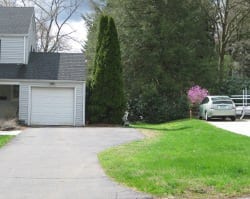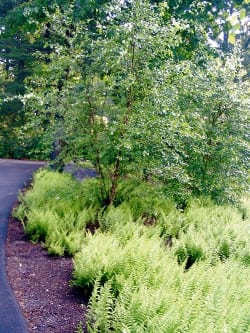by Clémence Corriveau
Water sustains and beckons us all: plants, animals, insects, and people. Yet, it can create challenges when it limits usable space or collects in the wrong location. By redirecting and reusing rainwater and by replanting to accommodate wetlands, you can turn problem garden areas into beautiful havens. Here are some examples of collecting rainwater in rain barrels and creating rain gardens and ponds to capture the treasure that water brings to the landscape.
Rain Barrels
Collecting the rainwater from all of the roofs on your property is a great way to conserve water, no matter how small the building may be. (Figure 1.) Using rain barrels is a wonderful way to store water for periods of drought and for watering flowerpots and vegetables in the garden. Adding a rain chain that cascades from the roof down to the barrel (Figure 2.) adds visual interest all year round, including during the winter when ice forms on the links and creates elaborate sculptures. (Figure 3.)

Figure 1. The surface of every roof provides an opportunity to collect water. A backyard shed with gutters fills two rain barrels with water that is used to replenish the nearby pond.

Figure 2. A rain barrel and rain chain at the corner of the house creates interest near the patio. Collected rainwater is used to water patio pots and the nearby vegetable garden.

Figure 3. Although the rainwater is not collected in the barrel during the winter, the rain chain provides a pleasing ice sculpture.
Rain barrels can also be used to slow down and redirect the water coming from a gutter. A former problem area near a client’s garage was solved by placing a rain barrel to collect the water from the gutter. (Figure 4.) A hose connected at the bottom of the barrel guides the collected water into an adjacent rain garden so during a heavy rain, the water flows into the garden where it is slowly absorbed. (Figure 5.) This simple rain garden also serves additional purposes. It is now an interesting area that used to be a plain strip of lawn between two driveways. By removing the lawn and excavating slightly so it is lower than both driveways, then planting river birches and ferns, we created a beautiful screen between the two properties. (Figure 6.) It became a lovely solution to water accumulating near the garage. Now water collects in a rain barrel and is effectively reused.

Figure 4. The challenge: Rainwater from the adjoining slope and from the roof of the garage ran off and accumulated into the area adjacent to the garage.

Figure 5. The solution: A rain barrel added at the corner near the garage collects the water from the roof. The lawn was removed from the adjoining slope and the ground was slightly excavated to hold on the runoff water. Although ferns are dormant, the interest and architecture of the river birches bring year round beauty and the plowed snow can be piled without hurting the vegetation.

Figure 6. The pay off: A rain garden can take many forms. Here, hay-scented ferns (Dennestidia punctiloba) and river birches (Betula nigra ‘Heritage’) work their magic to absorb the water while providing a screen between the two driveways.
Rain Gardens
Rain gardens are broadly defined as gardens composed of plants that grow in very wet soil. They are another way to transform a problem area into a beautiful garden.
One client had a yard with a high, grassy slope. Water pooled at the bottom constantly, creating a soggy, unusable space where her children would normally have played. As farmers have done for centuries, we terraced the slope with shrubs and perennials to reduce the amount of water that ran down the hill. In addition, the base of the slope was slightly re-graded to create a grassy area for the kids to play and a lower rain garden where the remaining water run-off collects and is slowly absorbed by the plants. This successful solution created through considerable grading and construction, transformed their backyard.
Another client came to me with a particularly challenging backyard property that was so wet it was unusable. (Figure 7.) The problem was caused by very dense clay soil that did not allow for adequate drainage. Because it was not practical to replace such an extensive amount of soil, we created a rain garden in a very large portion of the yard, and re-graded a small area for a lawn and patio near the house. The rain garden thrives in its designated location, and the homeowners flourish in their new usable space. (Figure 8.)

Figure 8. Three years later, the homeowners have a beautiful garden. All the plants flourish in wet poorly drained soil.
In spite of their names, rain gardens are not swamps. With careful planting, it is possible to create a sitting area near or in rain gardens that can be used most of the year. (Figure 9.) Plants such as Caltha palustris, Chelone glabra, Gentiana lause, Iris versicolor, Lobelia cardinalis, Lobelia siphitica, Trollius laxus, Clethra alnifolia, various Viburnums, Ilex verticillata, Rosa palustris, Hammamelis vernalis, Hibiscus mocheuto, Aronia ‘Brillantissima’, and of course the beautiful Betula nigra and various ferns thrive in these settings and create year-round, visual interest.
Ponds
Creating a pond in a problematic wet area has many benefits. The pond and its plantings will serve as a destination garden rather than an eye sore. (Figure 10.) It lures desirable and attractive wildlife, including frogs, dragonflies, and fireflies. (Figure 11.) A common concern about ponds and still water is that they attract mosquitoes; however, water pumps used in man-made ponds today keep the water moving and the presence of frogs controls the mosquito population. Adding bat houses in a garden can add additional natural mosquito control.

Figure 10. The more plants you add, the more interesting the pond becomes. It creates a myriad of habitats for the desirable wildlife. A sitting area makes it a destination as well as a focal point.
Planting a variety of grasses and perennials around the pond creates interest and attracts butterflies as well as other lovely insects. An attractive color scheme and a thoughtful selection of plants with diverse textures and heights result in a pleasurable environment to complement the pond (Figure 12.). Include a sitting area near the pond, as it always becomes a popular destination. You and your guests can relax and sip a glass of wine, while enjoying an evening concert provided by the frogs (Figure 13.). FYI: Frogs will move in very quickly after the pond is built – they are natural and free! Adding a fire pit to the sitting area will increase your enjoyment of this destination garden.
Man-made ponds demand only a minimal amount of maintenance. They don’t require any chemicals to keep the algae under control: a ball of barley, available on the Internet or at a well-stocked garden supply store can be placed in the pond once a year in the spring. Nothing else is needed. Use a rake in the spring to drag out any debris that fell into the pond during the fall and winter. Several times a season, take a minute to empty the pump filter bag to ensure that it will run properly.
If the pond is visible from the house, the movement of water caused by running the pump all winter creates the beautiful ice form to enjoy. Otherwise, it is absolutely safe to remove the pump for the winter and let the pond rest.
Building a pond can also be a practical solution to street noise. The sound of running water and a well-placed berm, or mound of earth constructed as a natural sound barrier, can camouflage traffic and other noise pollution. (Figure 14.)

Figure 14. Creating running water that emits pleasant sounds and the construction of a berm helps to reduce the noise of a busy street.
Water instinctively attracts us and turns a beautiful garden into a magical one. Collecting and using water in the landscape not only makes the outdoor spaces more attractive, but also protects and preserves the environment.
About the Author
Clémence Corriveau is the founder and owner of Ecological Landscape Designs, LLC. She has a Master in Arts in Landscape Design and Planning from the Conway School of Landscape Design. She is NOFA certified and, in addition to ELA, she holds memberships in Association of Professional Landscape Designers, New England Wild Flower Society, and the American Horticultural Association. Clémence may be reached at corriveau_landscape@hotmail.com.






